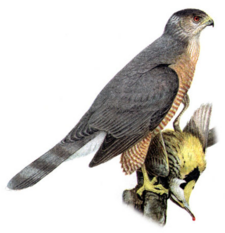Cooper's hawk
Cooper's hawk sometimes formerly called a chicken hawk (Accipiter cooperii) is a mid-sized hawk that preys on smaller birds and some small mammals; waiting from a concealed perch and then surprising them with a burst of acceleration. The hawk typically hunts in dense woods, but is also known for hunting in back yards and sometimes in urban areas. The species survived a period when it was considered to be threatened by hunting and pesticides and now thrives over a broad range. It was named for William Cooper, one of the founders of the American Museum of Natural History in New York.
Males of the species are smaller than females, averaging about 15 inches long with a 29-inch wingspan and 11 ounces to the females' 18-inch length, 33-inch wingspan and 17 ounces. They both have short, broad wings, long, rounded tails, and extended necks. They have red eyes, dark brown head-caps and yellow feet. Their backs are typically gray or blue-gray with rust-and-white banded chests. Juveniles have paler chests and brown backs.
Cooper's hawks, especially juveniles, are similar in appearance to Northern goshawks, but are generally smaller with longer tails and less distinct chest-streaks. Sharp-shinned hawks are generally smaller with square-ended tails and shorter necks.
Breeding pairs build nests high and close to the trunk in large trees in forested areas and usually lay a clutch of 3 to 6 pale blue-green eggs which incubate for a little over a month. Hatchlings are covered in white down and brood in the nest for four to five weeks before flying. They often return to the nest for a month of more before becoming successful hunters on their own. Because they hunt from perches, Cooper's hawks are not known for soaring (though they are capable). They generally dart through undergrowth chasing prey with a pattern of quick wingbeats and short glides.
In the Birmingham area Cooper's hawks are known to hunt pigeons downtown and a variety of birds at the Birmingham Botanical Gardens. They are also commonly seen preying on songbirds at back-yard birdfeeders in residential areas. In less-developed regions they tend to prefer heavy forest near running streams. Numerous hawks live in the region year-round and are joined in the winter by hawks from the northern range migrating south.
References
- Wilson, Jim and Anselm Atkins (2002) Common Birds of Birmingham 2nd edition. Decatur, Georgia: Hexagon Publishers ISBN 096672402X
- "Cooper's Hawk" (August 2, 2008) Wikipedia - accessed August 10, 2008
- Franklin, Paul H. (August 10, 2008) "Black Belt teems with Cooper's hawks, as does Birmingham area." The Birmingham News
